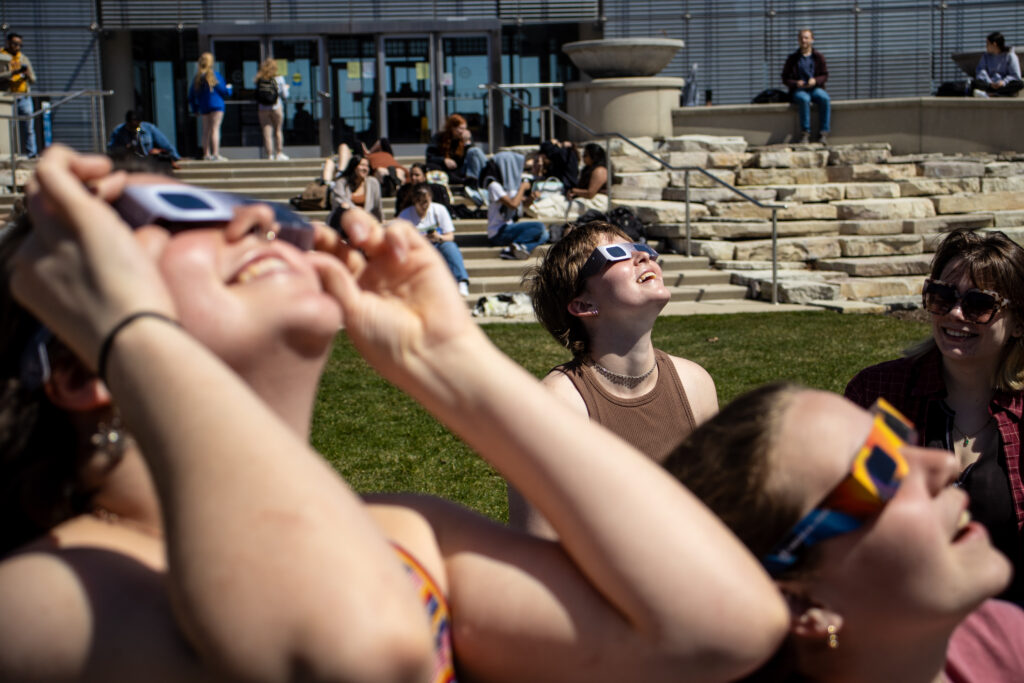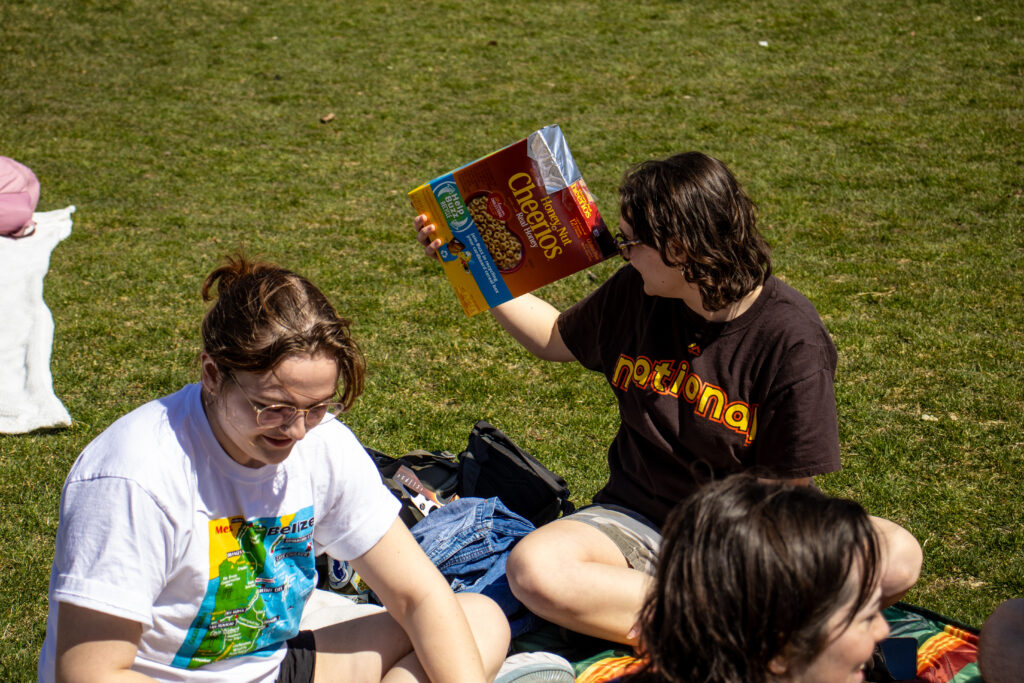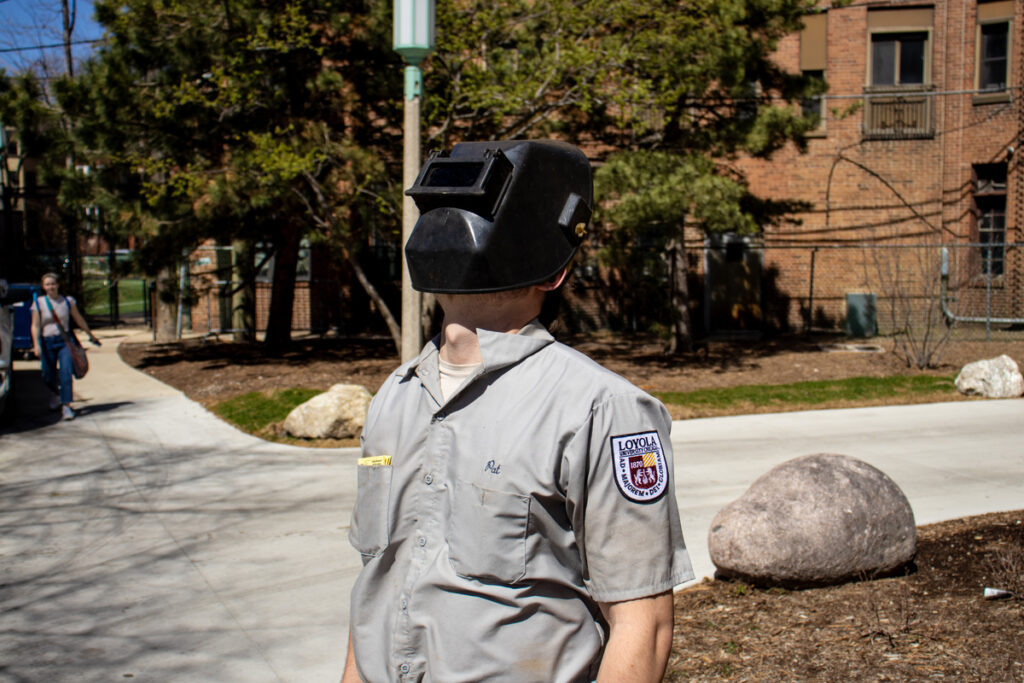The solar eclipse was the first visible in the United States since 2017 and the last until 2044.
Partial Solar Eclipse Gives ‘Shared Experience’ to Loyola Community
Loyola and the greater Chicago community experienced a partial solar eclipse April 8 as the moon obstructed approximately 94% of the sun. Hundreds of students and faculty made their way outside of the classroom to witness the early afternoon’s celestial phenomenon.
Dr. Willetta Greene-Johnson, who teaches physics at Loyola, said it was great for her to see students care about the eclipse — even if they didn’t study physics.
“We’re just interested in this common, shared experience and just enjoying all the universe has to offer us at the level that we want to enjoy it,” Greene-Johnson said.
She explained a solar eclipse involves the moon passing over the sun in such a way that it casts a shadow on the Earth. Monday’s solar eclipse was the first visible in the United States since 2017 and the last for two decades, according to NASA.

(Austin Hojdar / The Phoenix)
As the partial eclipse began around 12:51 p.m., second-year Bennett Korotko was positioning his Canon AE-1 film camera toward the sky.
The theoretical physics and applied mathematics major said he bought a neutral density filter to reduce the light coming in through the lens so it doesn’t ruin his photo or camera.
“I’m from Minnesota originally, so I’ve never actually had a chance in my lifetime to see it,” Korotko said. “I wish I could go a little more south to southern Illinois, but I’ll get what I can get. This is amazing.”
Cities like Dallas, Cleveland and Carbondale — a city about five hours south of Loyola — sat in “the path of totality,” meaning the moon fully passed over the sun making the cities appear as though it were dusk or dawn for a few minutes, according to NASA.
First-year finance major and Dallas-native Serena Patel said Airbnbs and hotel prices increased in her hometown as visitors flocked to experience the total eclipse. The 19-year-old sat outside the Information Commons and looked up at the sun with her solar eclipse glasses.
“The weather is really nice and honestly, there’s something wholesome about everybody being out,” Patel said.
Without wearing special solar eclipse sunglasses, looking at the sun during an eclipse can cause irreversible eye damage, according to Chicago’s Adler Planetarium.
Loyola’s physics department posted on their website they would be giving out a limited number of protective glasses outside Cudahy Science Hall on a “first-come, first-served basis.”
After waiting in advance for about an hour with her friends, third-year Olivia Sigunick said she was able to get a pair but felt there weren’t enough for all those interested in the event.
“There was probably, like, 200 people very tightly packed, crowded around,” Sigunick said. “I got one pair, and I tried to get out, and I couldn’t because nobody could move.”

Second-year D.J. Brown said he also didn’t get a pair of glasses but had seen the last solar eclipse in St. Louis in 2017.
“They was like, ‘It’s a once in a lifetime experience,’ and I saw it, and it was fire,” Brown said. “I was in middle school, and now I get to see it again.”
An estimated 215 million U.S. adults viewed the 2017 solar eclipse, while only 12 million lived in the path of totality, according to NASA. Around 32 million people live in the path of totality this year, and 99% of Americans were able to see a partial or total eclipse where they live.
Anthropology major Kara Ehler was also without glasses but used a makeshift pinhole camera from a Cheerios cereal box to view the eclipse. By poking a hole in aluminum foil, the moon projects its shadow onto cardstock glued to the bottom of the box.

“It’s a unique opportunity,” said Ehler, 21. “Most of us saw the one in 2017, right, but this is much more coverage, so I’m excited to see it.”
At 2:07 p.m., the hundreds of students on the east quad outside the IC broke out in cheers as the moon reached its maximum coverage of the sun for the Chicagoland area.
The next time a total solar eclipse will be visible in the contiguous United States will be Aug. 23, 2044, according to NASA.


